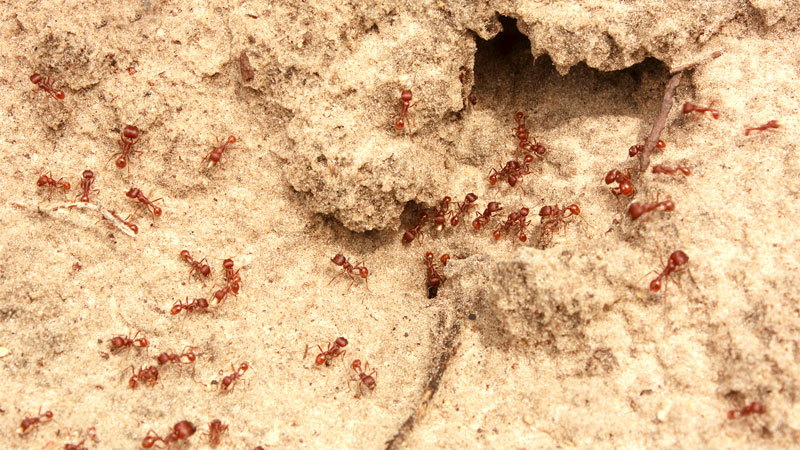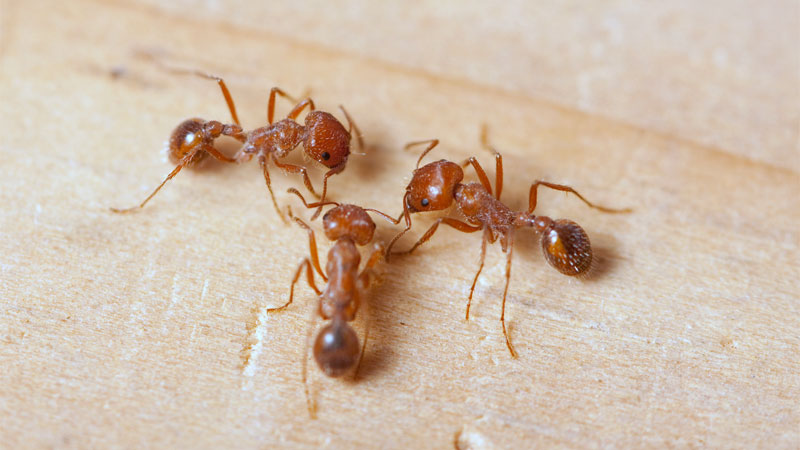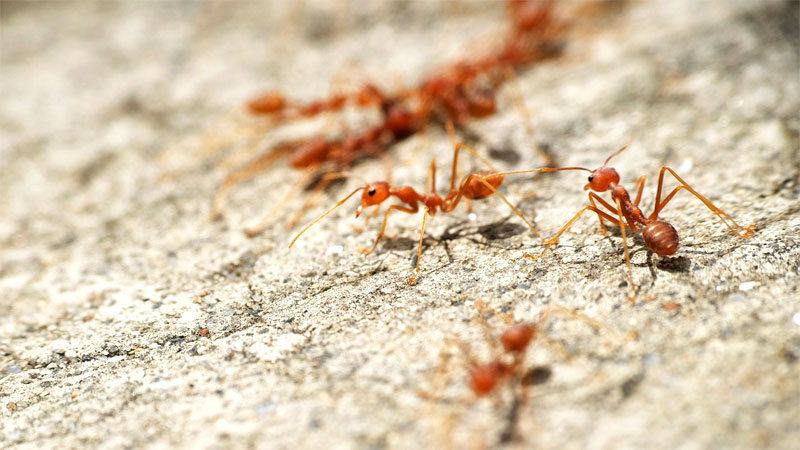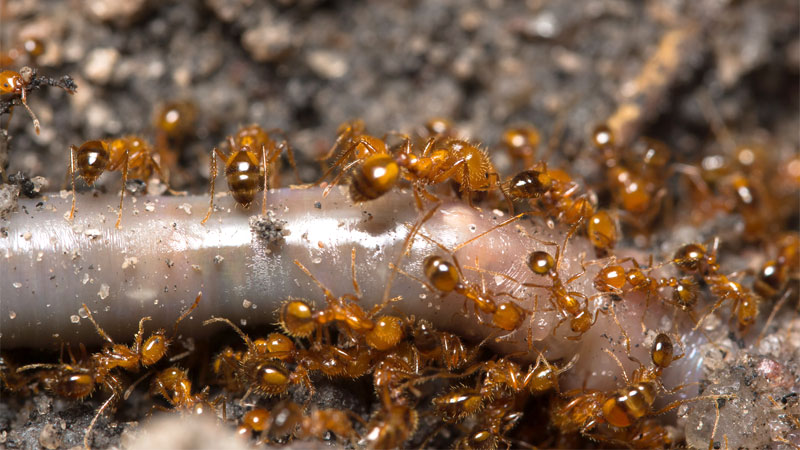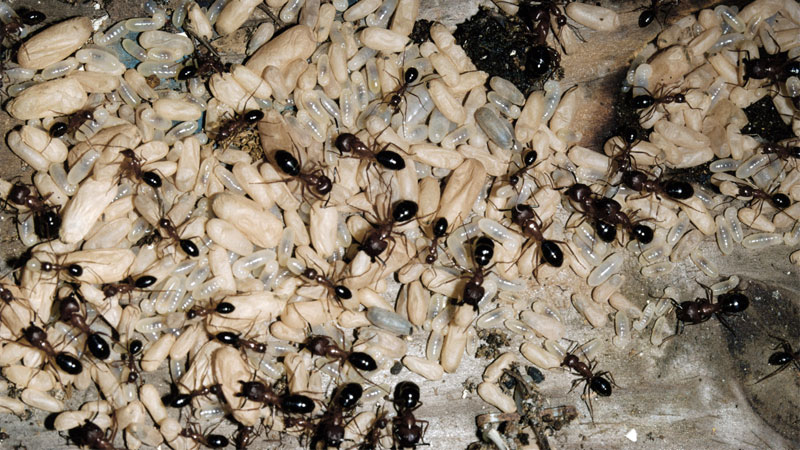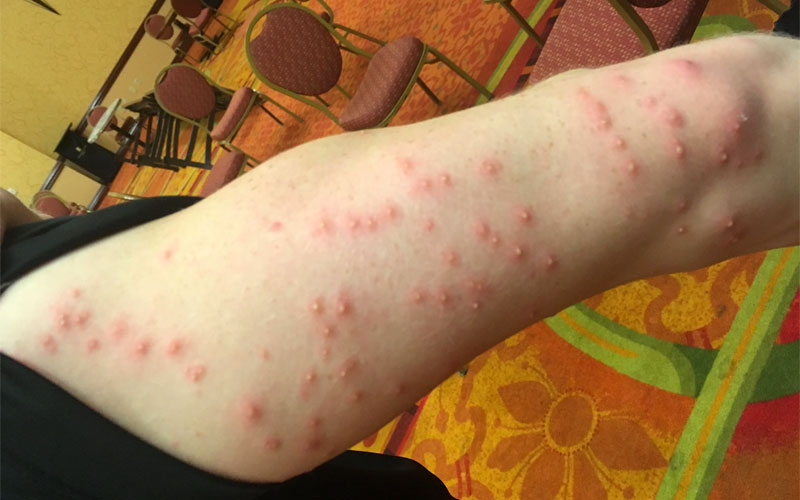You’ve heard the name countless times before. Perhaps you’ve even watched their lives play out on Ants Canada. But one thing’s for sure: there’s no real way to prepare for the first time you run into fire ants.
With 20 known species, not all fire ants behave like you’d expect. Today, we’ll take a look at how to fight these critters, then get into more detailed info on fire ants, especially the two notoriously invasive species.
Getting Rid of Fire Ants
Between their highly aggressive nature when threatened, their colonies (which can spread as far as 25 feet across), and the ability to form new colonies literally overnight, it can be incredibly hard to get rid of an infestation of RIFAs (red imported fire ants) or BIFAs (black imported fire ants).
Other fire ant species can usually be handled like regular ants, but these two have to be treated with care.
Here are some known methods for getting them out of your home, garden, and yard, as well as ways to attack them head-on (if you’re brave and/or foolish enough to risk it).
How To Get Rid of Fire Ants in House or Apartment Settings
There are three ways to deal with fire ants in the home: the bait, the home remedy, and the professional.
Baits
Bait traps designed for sugar ants are great because they won’t alarm a colony. Simply place them down at night in spots you’ve seen fire ant activity. The worker ants will readily take the poison bait home to their queen, killing her.
This method is very reliable so long as you don’t use the same product twice in a row. Doing so may result in the ants developing a tolerance.
- Attracts & Kills – Kills common household ants including acrobat, crazy,...
- Kills the Ants You See & the Ones You Don't – As worker ants discover the...
- Works Fast – You should see a significant decrease in the number of ants...
Known Drawbacks
There are a few downsides to using baits in this case, however. Not only do you have the usual risk of a child or pet getting hold of the bait trap, but these baits are slow-acting. This means your family will have to be very careful around the ant mound or trails. The good news is that this method won’t sound an alarm in the colony.
Glue Traps
When using baits, you may also want to use glue traps. This is simply some sticky tape placed face-up along the path the ants will follow in the morning. Alternatively, you can invest in a commercial glue trap like MAX-Catch.
Try placing it beyond the bait trap so any ants that don’t take the bait will get stuck trying to explore past it. Just remember, these ants will sacrifice themselves to create a safe path for other ants, so glue traps have limited use on their own.
Home Remedies
There are a lot of home remedies that work against fire ants (including RIFAs and BIFAs), but they’re not always a one-and-done. For example, you can use citrus, vinegar, bleach, or even saltwater sprays to kill on contact, but this won’t kill the queen or any ants still in the colony. There’s also a risk of putting the colony on alert if you do this.
You can also make a homemade bait trap by mixing a bit of boric acid into some honey or corn syrup and dabbing it onto a piece of parchment paper. Place the paper where you’ve seen fire ant activity, but be sure to keep children and pets away from this potent poison.
Calling a Professional
Let’s be honest here, super colony ants such as RIFDs, BIFDs, or Argentine ants can be difficult to eliminate on your own. In most cases, the safest remedy is to call in a professional exterminator. They’re able to eliminate entire colonies safely and effectively, although the cost will be higher than most DiY methods.
How to Get Rid of Fire Ants in the Garden
There are a few good methods for the garden, such as diatomaceous earth (which we’ll discuss later on). However, the two best ways to get fire ants out of the garden are to remove any garden pests and use complimentary gardening.
- Natural Product - Composed of 4lbs of 100% ground freshwater diatomaceous earth...
- OMRI Listed - Listed with the Organic Minerals Research Institute, a non-profit...
- Powder Duster Included - Powder duster in the bag for easy and efficient...
Do Fire Ants Eat Sugar? Garden Pest Symbiosis 101
Fire ants absolutely love sugary substances, so any infestation by aphids, mealybugs, or other piercing insects will be an open invitation. The honeydew these critters produce is a staple food source for both fire ants and many other species. In fact, the ants will often guard these common plant pests.
Complimentary Gardening
On the other hand, complimentary gardening simply involves planting flowers or herbs that help protect other plants. Lemongrass, peppermint, and sage all give off strong scents that can override the chemical trails ants lay down to show the way to food or the colony.
Garlic, onions, and other related plants are especially useful, as they repel a wide range of pests.
Plant your companion plants around the border of your garden or even intersperse them. They’ll keep pests at bay while inviting beneficial insects and pollinators. Perhaps best of all, many of them can be used for cooking!
In the Yard
Your yard or lawn is perhaps one of the best battlefields to fight on. In fact, there’s a chance you’ve already prevented several fire ant infestations without knowing it! Here are two easy tricks for keeping these areas fire ant free.
Regular Lawn Maintenance
You may be able to fend off fire ants by simply maintaining a healthy lawn. Many lawn treatment products include pesticides and herbicides that can kill a fire ant colony early on and protect your yard from further incursions.
Also, while fire ants aren’t attracted by clutter, many other pests are. This can create a potential food source for fire ants. Thus, by keeping your yard free of debris or standing water, you will naturally reduce the risk of a fire ant invasion.
Natural Predators
A wide range of critters will be more than happy to pick off the ants one by one. However, not all critters deserve their reputation for munching on fire ants. Also, keep in mind that predators can help control a population but won’t eliminate it. Let’s look at a few of these rumored hunters.
Do Armadillos Eat Fire Ants?
Armadillos will munch on fire ants whenever they have a chance. Their thick skin provides some degree of protection from bites, although some parts aren’t as well armored.
Do Birds Eat Fire Ants?
Many insectivore birds do indeed snack on fire ants. Much like the armadillo’s thick skin, birds are able to swoop in and escape before the fire ants can retaliate.
Do Possoms Eat Fire Ants?
You might have heard claims that the opossum eats fire ants, but this isn’t actually true. In fact, the rumors are based on one of the nicknames given to armadillos, not opossums themselves.
Do Spiders Eat Fire Ants?
Spiders are perhaps the most active hunters of fire ants. From the skilled wolf spider to orb weavers, ants are easy prey for most predatory arachnids.
How to Kill Fire Ants
This topic deserves its own section, as killing fire ants can be rather dangerous compared to convincing them to walk away.
If you plan on using these methods, be sure to go out at night and wear protective gear, so the ants can’t get to your skin. You’ll also want to hose down with soapy water before going inside to make sure no ants are still on you.
Remember, it only takes a handful of workers to start a new colony!
See Also: How to Kill Pavement Ants
Diatomaceous Earth (DE)
This tried-and-true solution is all-natural and safe for use around your pets and kids (although you should still limit exposure).
DE is made of the crushed, fossilized remains of microscopic diatoms. Food-grade DE may seem like a powder to you or me, but for ants, it’s like walking on broken glass. Even more importantly, the sharp fragments lacerate the ant’s exoskeleton, which causes them to dehydrate to death.
- Natural Product - Composed of 4lbs of 100% ground freshwater diatomaceous earth...
- OMRI Listed - Listed with the Organic Minerals Research Institute, a non-profit...
- Powder Duster Included - Powder duster in the bag for easy and efficient...
What makes this one of the best methods (if you’re careful) is that you can sprinkle it around the nest area liberally. The fire ants will swarm out to their own doom when the colony sets out for food. The downside is that you’ll need to reapply if it rains or every few days because moisture can render this wonderful substance useless.
Boiling Water
This can be a highly dangerous method and will harm or even kill any plants that are too close to the nest. However, it has a very high success rate. Simply boil a few gallons of water and slowly pour it over the mound.
DO NOT use this near electronics for obvious reasons, and be careful not to burn yourself. The water will kill on contact, although it might not completely wipe out the colony if it fails to flood all of the corridors and chambers.
Also, note that the water will cool as it soaks through the ground. Many of the ants will thus end up drowning instead of getting cooked.
Chemical Insecticides
While not always the best idea (because they can harm beneficial insects, contaminate soil, and pose a toxic risk for children and pets), you may find the need to resort to an insecticidal spray. A good fire ant killer like Ortho Orthene, whether dust or liquid, will quickly take out most, if not all, of a colony.
- Kills the queen and destroys the mound
- No watering-in required
- Treats 54 mounds
If you choose to go with an insecticide, pick one that is designed to work on fire ants and be sure to follow all instructions carefully. You can spray many of these on the ants directly, while others are residual and can be safely used at night.
Getting to Know Fire Ants
When it comes to fire ants, there are about 20 species of true fire ants. However, there are many others that are regionally identified as fire ants due to coloration or their sting/bite.
These little critters have a reputation for being red, having a painful bite, and swarming their prey. But these attributes aren’t exactly true. Many species are actually black or are relatively docile.
True fire ants come from the genus Solenopsis, which contains approximately 200 different species and is best known for the thief ants. Several species of fire ants are native to the US and are pretty much harmless, but two invasive species are quite the opposite. These are the two we’ll be focusing on most.
Identifying Fire Ants
Fire ants vary greatly in size and coloration, and you’ve likely encountered native fire ants without ever noticing. These behave much like the average sugar ant*, and can be hard to distinguish visually unless you’re a myrmecologist – someone who studies ants.
However, the two species we’ll be focusing on are very different.
Red Imported Fire Ant
Solenopsis invicta has become known as the red imported fire ant (RIFA for short). It has workers of different shapes and sizes, making it more difficult to identify them visually.
However, females tend to have a yellowish-tinted head and thorax with a brown to black abdomen. Males are completely black. The species name means “undefeated” and describes the vast expansion of this pest quite well.
Black Imported Fire Ant
The other species is Solenopsis richteri, which was once thought to be a subspecies of the RIFA. Commonly referred to as black imported fire ants (BIFAs), this species is a bit less aggressive, more cold-hardy, and exhibits different behaviors from RIFAs.
Despite the name, these ants have similar coloration, with males being all-black and females being a dull yellowish brown with black on the abdomen. However, they may appear dark brown to black from a distance.
Both of these species tend to range between ⅛ and ¼ inches long. They’re more likely to be found outdoors but have been known to invade homes in search of food.
Where Do Fire Ants Live?
Both imported species are originally from South America and have slightly different ranges in the US.
- RIFAs can be found throughout the southern states (ex: Texas) from coast to coast and northward into Oklahoma, North Carolina, Tennessee, and Virginia.
- Meanwhile, the BIFA seems to be contained to Alabama, Mississippi, and Tennessee.
Fire Ant Nests
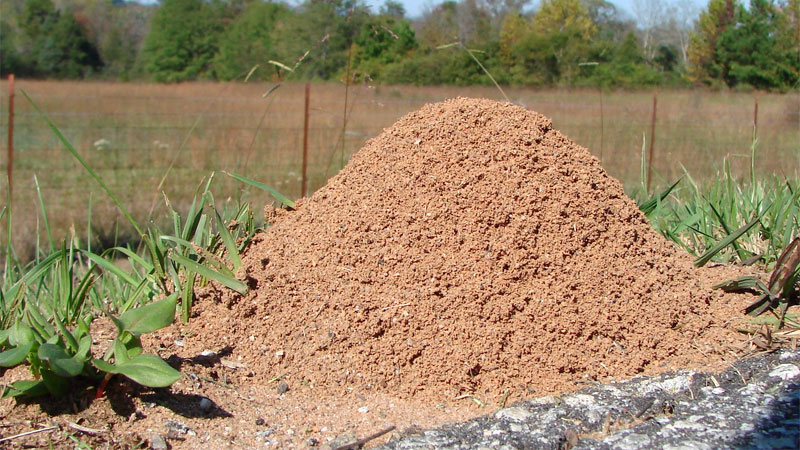
As with most ants, fire ants live in underground colonies. These two species tend to build mounds, but have also been known to nest in manmade structures, including electronics such as HVAC units and junction boxes. This can cause a lot of damage and also lead to some pretty nasty surprise encounters.
While we don’t know why, fire ants seem to be attracted by electrical currents, resulting in these unusual nesting alternatives.
The mounds can be built in almost any soil type. They’re more likely to build somewhere open and exposed to the sun than in a sheltered, overgrown location. This doesn’t mean your garden is safe, as there are food sources present. Additionally, you might not even spot the mound, and the colony isn’t restricted to a mound’s location.
See Also: 15 Ways to Get Rid of an Ant Hill
Another tricky point about the nesting habits of these critters is that some colonies may have multiple queens, while others tend to only have one. And it only takes a couple of workers on an evening march to create another colony hundreds of feet away from their home colony.
Some populations will migrate to follow food sources, and a massive population explosion can occur in only one or two months.
What Do Fire Ants Eat?
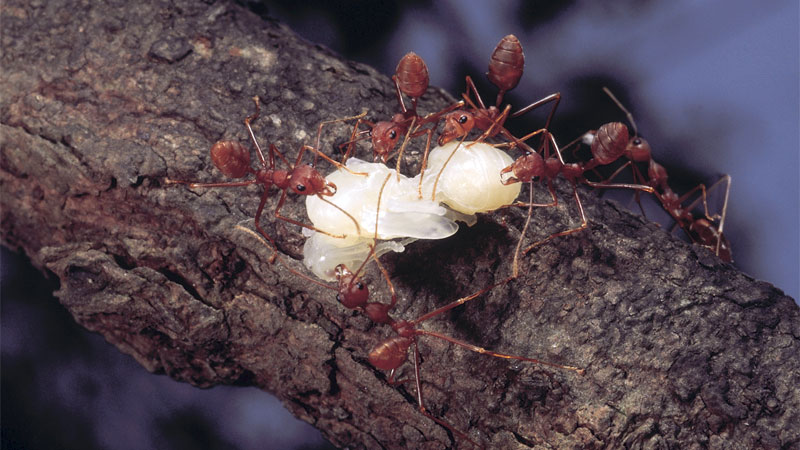
All fire ants prefer sugars (although they do consume some protein). This is usually in the form of plant sugars, which may come from harvesting plants or collecting honeydew.
However, BIFAs and especially RIFAs are known to swarm and attack insects, birds, rodents, and even reptiles, which they’ll dissect and take back to the colony.
Do Fire Ants Sting or Bite?
Fire ants are capable of stinging, but RIFAs and BIFAs also have a strong bite, fueled by four sharp teeth on their mandibles. When biting or stinging, they inject an alkaloid venom. This results in a painful bite that leaves behind a red and white pustule.
Oddly enough, the bite of a single RIFA only rates 1 on the Schmidt scale (as do two native fire and species), which is about as intense as a bumblebee or sweat bee sting.
By comparison, more aggressive bees and many of the less aggressive wasps rate a 2 on the scale. Very few insects are a 4, which is the most intense level on the scale.

However, there’s a very good reason for this low ranking – RIFAs almost never have a solo attacker and tend to swarm viciously, whereas Schmidt (quite intelligently) isolated a single ant for his intentional encounter.
While BIFAs are less aggressive than RIFAs, they will still swarm anyone or anything that disturbs their nest or appears to be a threat. The most common places they’ll attack is an exposed hand, working their way up the arm, or a bare foot and up the leg. They’ll also attempt to scale up any furniture that is placed too close to the nest.
Related: Schmidt Sting Pain Index For Bees, Wasps, and Hornets
What To Do If Fire Ants Bite You
The first thing you need to do is get away from the place you’re getting bitten before more ants show up. Try to get all of the ants off of your body quickly so they can’t perform multiple bites or stings.
While generally not harmful, the venom contains several substances that can lead to an allergic reaction. It’s usually this reaction that causes the painful sores to last for a week or more and can make them prone to secondary infections.
Allergic reactions will vary from one person to the next. Common symptoms tend to range from some nausea or dizziness to severe symptoms such as trouble breathing or swallowing.
Depending on your level of allergy (and how much of the venom you were exposed to), a fire ant attack can become life-threatening. If you start having symptoms, you should see a doctor immediately.
Also, it’s important to note that while only about five percent of RIFA attacks on humans lead to a fatality, the risks are very high for pets and livestock. Children can also be at higher risk due to their size. You should seek medical attention immediately in these cases to be safe.
Related: Do Ghost Ants Bite?
Fire Ants vs Red Ants
As we’ve mentioned earlier, RIFAs aren’t actually red – although (like BIFAs) they can appear to be the color they’re named for at a distance due to their tiny size. This can lead to confusing RIFAs with red ants.
However, most red ants are larger, coming in at between ⅓ and ½ inches long. The most common red ants are red carpenter ants (Camponotus chromaiodes and Camponotus ferrugineus), which are mostly docile and one of these ants will only attack if in danger.
Another important difference is that carpenter ants prefer rotting wood and are nocturnal, whereas fire ants live underground (or where there’s electricity) and are primarily diurnal.
- How to Get Rid of Hawks - March 8, 2024
- How to Get Rid of Pill Bugs (Rolly Pollies) - March 1, 2024
- How to Get Rid of Groundhogs (Woodchucks) - February 5, 2024

